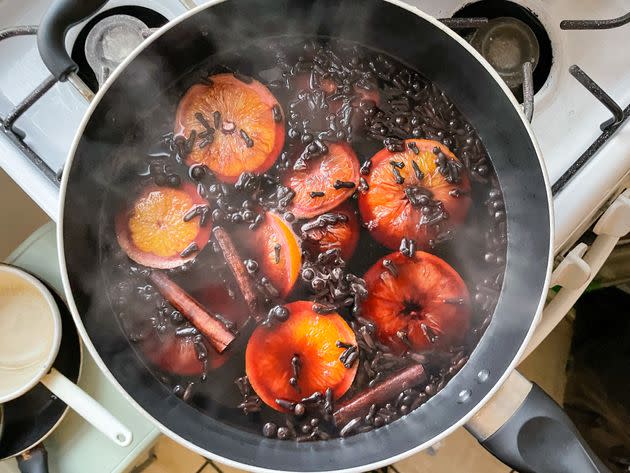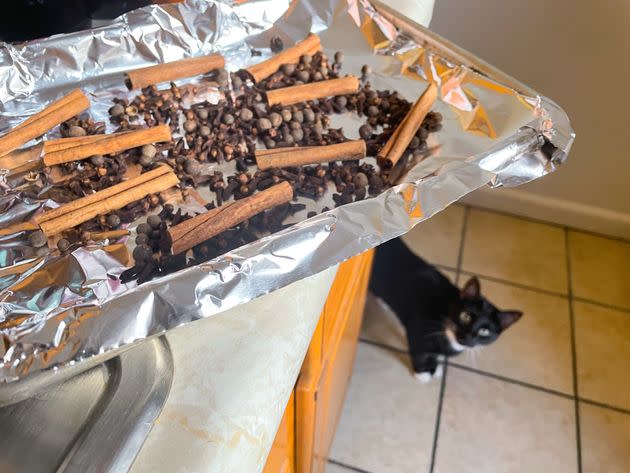How To Make The Best Mulled Wine Ever: Tips From The Pros

Once upon a time, someone was holding a glass of red wine and said, “You know what would make this even better? If it were hot and full of sugar.”
Or something like that, anyway. Legend has it that mulled wine originated with the ancient Greeks as a way to use up leftover wine and prevent waste. By the Victorian era, it had become associated with Christmas, and nowadays we tend to associate it with aged little packets of seasoning somewhere in the very back of the kitchen cabinet.
If your personal idea of mulled wine is something stodgy and overly sweet, consider wiping the slate clean and giving it another shot. Not only is mulled wine still served around the world during colder months ― including in trendy bars and restaurants, not just dusty old pubs ― it’s also a relatively easy batch cocktail that can be made to taste. You can find virtually infinite mulled wine recipes online, but at its core, it’s just a matter of finding the combination of wine, fruit and spices that suits your palate.
If you’re looking to perfect your own mulled wine recipe, read on. We’ve gathered tips and tricks from professional bartenders and chefs on how they make delicious, modern mulled wines that will keep your guests coming back for another ladleful.
How to choose a wine
From ancient times to now, one rule remains constant when it comes to mulled wine: Start with a cheap base. Mulling was intended to improve leftover wines, and it gives you tons of room to tweak the flavors to your taste, so there’s no reason to use a really expensive bottle that would be better enjoyed as is.
As Monica Collins, bar manager at Lucky Rooster Kitchen and Bar in Hilton Head, South Carolina, puts it, “Choose a Monday wine, not an anniversary wine ― when in doubt, use what you would also drink by the glass.”
Grab a few “Two-Buck Chucks” or use up that bottle that’s been haunting your pantry for God-knows-how-long. Just keep in mind that the heat will intensify the wine’s flavor, so don’t use one you really dislike.
If you’re making a traditional mulled wine, be sure to use a dry red as your starting point, said Gary Wallach, beverage director at Lindens in New York.
“You’re going to add sweetener in other ways, so using a sweet wine will unbalance the flavor,” Wallach said.
Using a drier wine for your base gives you more control over the final product. Remember, you can always add more sugar, but you can’t take it out.
But now, here’s some extra credit for advanced students of mulled wine: Your base actually doesn’t have to be a red wine at all. “People usually think of red wine as a base for mulled wine, but dry, acidic white wines are a refreshing alternative,” Collins said.
If you’re going to stray from the classic recipe, be intentional about it. Collins suggests using “a riesling, maybe a white Burgundy, add some sugar, brandy, and cardamom,” to switch it up.
Spice up your life
Spices are arguably the most creative and open-ended part of making mulled wine. The most commonly used spices are cinnamon, star anise, allspice and cloves, but you might also want to play around with fresh ginger, nutmeg, vanilla beans and so on. You can find a recipe if it makes you more comfortable, but it’s pretty hard to mess up too badly. Just stick to whole spices, not ground. And before you introduce your spices to the wine, Wallach suggests toasting them.
“You can release deeper notes within the spices like cinnamon, nutmeg and cloves if toasted,” he said.

You can strain them out with a cocktail strainer when you serve, or make your life a little easier by not dumping them directly into the pot to begin with, a suggestion from Ian Abriatis, bar manager at Brasserie la Banque in Charleston, South Carolina.
“I prefer a sachet of cheesecloth for my spices,” Abriatis said. “The smaller spices like allspice and clove tend to become a nuisance when drinking the wine. However, I do like to leave the citrus loose, floating through the wine.”
If you’re freestyling the recipe, Collins offers a good rule of thumb: “Light-bodied wines go with green spices like cardamom and basil, fuller-bodied wines with baking spices like nutmeg, such as pinot noir or a petite syrah.” The most traditional mulled wines are going to fall into that latter category, but don’t feel boxed in if you’d rather lighten things up with a zinfandel or even a white wine, per her tip above.
And no matter what combination of spices you go with, you probably aren’t going to want to let them sit in the pot all night.
“Be sure you steep your spices or herbs carefully,” cautioned Robert Kidd, bar manager at Le Cavalier in Wilmington, Delaware. “If you’re using dried spices and herbs, you will be adding extra tannin to wine that already has tannin. So, keep tasting while you’re steeping the herbs and the moment you notice any added astringency, take all the modifiers out of the wine.”
How much sugar should you add?
Don’t underestimate the importance of sweetness in a mulled wine. Seriously, even if you’re a dry wine person, mulled wine just doesn’t taste right without a healthy dose of sugar.
Not that you’re beholden to regular old white sugar. Wallach encourages branching out into other sweetening agents. ”You can use sweetener or simple syrup, but it will have a more natural taste with additions like honey, agave or herb syrup, and it all depends on what you’re looking to do,” he said. (Personally, I like to go with maple syrup.)
Apart from actual sweetener, you’ll be lightening things up, of course, with fruit. Dianne Lowry, ofThe Bedford and Macchina in Brooklyn, shared her preferred sweetening method. “I like to use dehydrated oranges and fresh oranges to add a layer of sweetness without adding too much sugar,” she said. “I also like to use unprocessed sugar to enhance and bring the flavors together.”
Oranges are the standard fruity addition to mulled wine, but feel free to experiment with other citrus, cranberries, blackberries, apple, what have you.
Add an extra kick
Typically, mulled wine includes a generous splash of brandy or liqueur. (Yep, if you’re a guest, be careful with that.) Lowry offered some advice on choosing a spirit to fortify your batch.
“Each ingredient is important, so you don’t need to spend a fortune on the brandy,” she said. “However, it is important to note that as you heat up the alcohol, the imperfections of the spirit are usually amplified.” Lowry recommends apple brandy as an agreeable addition.
Abriatis seconded this: “I like to use a mid-tier brandy that is going to showcase a lot of body and rich, spicy bites. Using an apple or other fruit brandy is a nice choice that is often overlooked as well.”
Liqueurs are also an option. If you’re using an orange liqueur, Abriatis recommends curaçao over triple sec for greater depth of flavor.
The secret ingredient is up to you, so ultimately, go with something you like when concocting your own personal mulled wine recipe. If you’re going to spend a little more on any of your ingredients, you probably want to do so on the spirit, since its flavors and scents will be magnified by the heat. Using something on the nicer side can help you avoid making a beverage that tastes (and smells) overwhelmingly boozy.
“When heating up alcohol, you tend to release some of the lesser wanted aromas,” Wallach said. “Using a quality spirit will give better control of that.”
Bring the heat
Heat plus alcohol ― you’d be forgiven if you find this part confusing. When you splash some wine into your pasta sauce, as you probably know, the alcohol cooks out. But that’s probably not the effect you want with your holiday spirits.
To keep from passing the point of no intoxication, Abriatis says you need to keep your batch under 170 degrees Fahrenheit at all times so the alcohol doesn’t begin to vaporize.
“You want to see the mulled wine just begin to steam, but no bubbles forming in the liquid,” Abriatis said. If you’re warming your wine on the stovetop, he recommends keeping it at a low heat throughout.
Since you’re just steeping the ingredients together, not cooking them, time is your friend. Yes, keep an eye on the pot and taste it often to make sure the spices aren’t beginning to make it more bitter than you’d like ― but apart from that, be patient. Keep it low and slow, and let the flavors meld for a solid 10 minutes at the very, very least. (It can safely stay on low heat for up to 6-8 hours, Abriatis said.)
Stovetop or slow cooker, red or white ― whatever you choose for your own personal mulled wine, don’t worry about being a perfectionist. Use a recipe if you want, or just wing it; carefully select your ingredients or use what you have on hand. If there’s any drink you can feel free to play around with, it’s mulled wine. Or as Abriatis put it: “Don’t be married to the recipe, just use it as a framework. It’s your mulled wine, so make it the way you enjoy it most.”
Need some mulled wine recipes to get started? Check these out.
This article originally appeared on HuffPost and has been updated.





